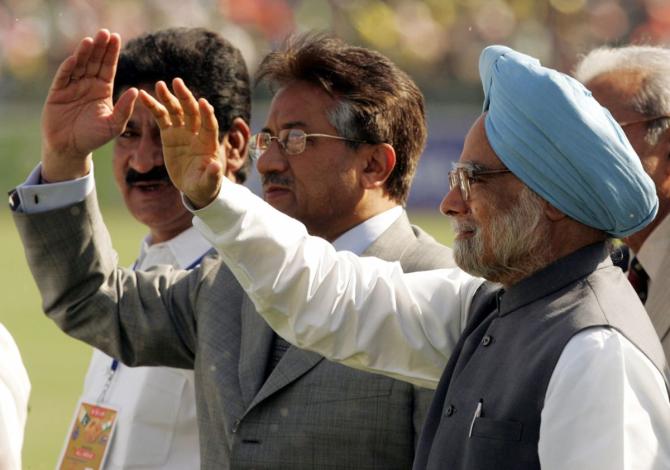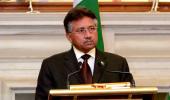Manmohan Singh and Musharraf felt that what they were embarking upon, if successful, could lead to a future of boundless potential for the two countries and for the relationship that was hard to foresee from the prism of the existing situation and the historical position and orthodox ideas on both sides.
A riveting excerpt from Ambassador Satinder Kumar Lambah's In Pursuit Of Peace: India-Pakistan Relations Under Six Prime Ministers.

After having failed to resolve the Kashmir issue, either by military or non-military means and specially after the Kargil misadventure, General Musharraf came out with a four-point formula on Kashmir.
Musharraf was aware of the history of Pakistan's reluctance to pursue the plebiscite route under the UNSC Resolution 47, notwithstanding the country's official public position on it. He had seen the non-viability of any formula that entailed fresh divisions or new boundaries being drawn.
The lessons of the Kargil misadventure also showed him the futility of military intervention to wrest Kashmir from India, although it took some time after the end of the Kargil War and reported persuasion by his US interlocutors to reach that sober conclusion.
Musharraf's new interest in settlement and peace may have been the result of the Kargil War, but it would also have had to do with the consolidation of his own position, in the dual role of a president and army chief, as also his ambitions for his legacy.
He understood that the framework could not harp on positions that would be unacceptable to India, but had to be something that would change the status quo in a positive way for Pakistan.
The formula would also address the aspirations of the people of Kashmir, as the interest of the people of Kashmir had been the central pillar of, and projected justification for, Pakistan's Kashmir campaign at home and abroad.
Over the period of 2001-2006, Musharraf articulated, with varying degrees of detail, what amounted to his four-point proposal. But, for him, the starting point was to narrow down the issue to the region of Jammu and Kashmir that needed a resolution-essentially the Kashmir Valley.
His four points were i. Demilitarisation together with the cessation of military activities;
ii. Self-governance in the region;
iii. A joint mechanism involving representatives of India, Pakistan and Kashmir, for the purpose of overseeing self-governance and for issues that were beyond the scope of self-governance; and
iv. Trade and movement of people between the two parts of Kashmir.
The principles were, of course, to be applied equally on both sides.
His formula clearly recognised that the stated positions of the two countries on the territory of Jammu and Kashmir were not acceptable to either side, and an approach was required that obviated the need for settlement of the territorial issue.
His proposal on a joint mechanism would result in a 'status quo plus' outcome for Pakistan with a say in the affairs of all of Kashmir. At the same time, self-governance in Kashmir would appear to be a fulfilment of Pakistan's commitment to the people of Kashmir and bury the possibility of independence.
As soon as the four-point formula was released in bits and pieces, we did an internal study and found it would be manageable to discuss Jammu and Kashmir with Pakistan on the basis of this formula along with Prime Minister Manmohan Singh's Amritsar speech.
As regards the regions, it was made abundantly clear that because of Pakistan's mishandling of the territorial issue since 1947 (creation of PoK) and 1963 (illegal cession of territory to China), the area to be discussed was the entire state of the erstwhile state of J & K.
Musharraf wanted to know if discussions could be limited to the problematic areas. His objective appeared to be to keep out the Northern Areas in the Pakistan side and Ladakh on the Indian side. Right from the beginning, it had been made clear to Pakistan that communal settlement was not acceptable.
The other element was disarmament. It was made clear to our Pakistani back-channel interlocutors that our forces had to deal with our China border as well.
The important element of the four point formula was demilitarisation. Musharraf said he understood total disarmament could not take place in a day and suggested two stages.

Pakistan would be willing to withdraw troops on the LoC as part of an overall settlement to deal with military confrontation between the two countries. He wanted Indian troops to be shifted from urban centres like Srinagar, Baramulla and Kupwara.
This he justified as a part of the well-being and human rights of the Kashmiri people. Pakistan was told that there had to be an end to hostility, violence and terrorism. There could be withdrawal of Indian troops from selected urban areas if this was put into practice.
For the first time, Manmohan Singh came up with the idea of economic integration through soft borders.
Borders, he said, could not be redrawn but progressively softened by encouraging trade and travel, the results of which were already apparent during the 2006-08 period when it started.
In any case, our own Kargil Review Committee had mentioned that the large-scale involvement of army encounter and insurgency operations was not in our interest. The removal of the Indian Army troops from internal security duties would also be in accordance with the report of the Kargil Review Committee.
Pakistan was aware that the reduction of army deployment in internal security duties in Jammu and Kashmir was already under way as part of the internal process.
Another important point was self-governance for internal administration. What was agreed to was not in violation of both the Indian and Jammu and Kashmir Constitution.

A brief history of the UN resolution and negotiations on various formulas by the two sides show that the narrative prevailing since 1947 was changed by Dr Manmohan Singh who said there can be no change or redrawing of borders.
Prime Minister Singh and President Musharraf approached the issue from different perspectives, but there was enough convergence to provide a substantive basis for dialogue and negotiation.
Dr Singh was clear that there could be no settlement along communal lines, so he wanted to deal with the entire state of Jammu and Kashmir, not just the Kashmir Valley.
Beyond that, though, Dr Singh's own internal initiative on Jammu and Kashmir and the recommendations of the working groups contained elements that would also be consistent with the approach to negotiations with Pakistan.
Reducing military presence in the state was an internal objective, but Dr Singh was clear that it also required an end to, or at least reduction in terrorism emanating from Pakistan.

Similarly, the question of good governance and autonomy to Jammu and Kashmir within the Constitutional framework of India, which had progressively eroded, was also being examined as part of a set of internal measures to advance peace in the state and address the concerns of the people. But, he did not go as far as proposing self-governance or joint sovereignty of the two countries.
Dr Singh proposed three ideas that would change the status quo, without redrawing the borders. At the same time, it would provide the people of Jammu and Kashmir, on both sides of the LoC, a deeper sense of control of their destiny, as also the benefits that arise from interaction, connection and collaboration.
He advocated free movement of people, goods and ideas across the LoC. Second, he suggested that the two sides of Jammu and Kashmir could develop joint mechanisms of consultation and cooperation for common social and economic development. And, third, he suggested that the common resources of the whole area should be used for the benefit of the people of the whole of Jammu and Kashmir.

Thus, for all the differences in substance and nuances, there was sufficient basis to move forward with negotiations. Both also realised that by keeping out the territorial issue, they were leaving it to be addressed in the future.
But they also felt that what they were embarking upon, if successful, could lead to a future of boundless potential for the two countries and for the relationship that was hard to foresee from the prism of the existing situation and the historical position and orthodox ideas on both sides.
Excerpted from In Pursuit Of Peace: India-Pakistan Relations Under Six Prime Ministers by Satinder Kumar Lambah, with the kind permission of the publishers Penguin Random House India.









